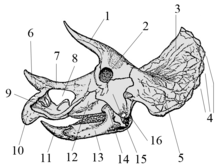Epoccipital

The Epoccipitalia are bones that are found in the neck shield of dinosaurs from the Ceratopsidae group . These bones line the edge of the shield and are responsible for its wavy appearance. The name Epoccipitale is misleading as these bones are not related to the occipitale of the brain skull . Instead, they sit on the shield-forming bones of the roof of the skull , the scale and parietal bones . In the more recent specialist literature, the terms epiparietals (on the parietal bone) or the parietal bone are often used as an alternative, depending on the location on the neck plate.Episquamosalia (on the cuticle ) used. Epoccipitalia were believed to be present in all ceratopsids, with Zuniceratops as a possible exception. The term Epoccipitale ( Gr. Έπί ( epi ) for "at", "to" and Latin occipitium for "back of the head", "back of the head") was coined in 1889 by the famous paleontologist Othniel Charles Marsh .
Epoccipitalia begin as separate bones formed by desmal ossification , but in adults they fuse with the parietal bone or the parietal bone. These bones are very variable in different species of the Ceratopsidae. In Ceratopsiden with a short shield ( Chasmosaurinae ), the Epoccipitalia were generally more triangular with a broad base - a well-known example is the sawtooth-shaped edge of the shield of the Triceratops . In representatives with a long shield ( Centrosaurinae ), however, they were elliptical with a narrower base. Especially with Centrosaurinen such as Centrosaurus , Pachyrhinosaurus and Styracosaurus , these bones were long and spiky or hook-shaped, depending on the species, they vary in number, shape and orientation. Epoccipitalia are therefore one of the most important diagnostic features (distinguishing features) within the Ceratopsidae.
The function of these bones was believed to be visual - they were likely used for display or identification.
Individual evidence
- ↑ a b Peter Dodson: The horned dinosaurs . Princeton University Press, 1996, ISBN 0-691-02882-6 , pp. 49, 63 .
- ↑ a b c Peter Dodson, Catherine A. Forster and Scott D. Sampson: Ceratopsidae : In; D. Weishampel, P. Dodson and H. Osmólska (Eds.): The Dinosauria . University of California Press, 2004, ISBN 0-520-24209-2 , p. 502
- ^ JR Horner & MB Goodwin: Ontogeny of Cranial Epi-Ossifications in Triceratops. In: Journal of Vertebrate Paleontology , Vol. 28, No. 1, pp. 134–144, 2008. (digitized version )
- ^ Peter J. Makovicky: Marginocephalia . In: MK Brett-Surman, Thomas R. Holtz, James O. Farlow (Eds.): The Complete Dinosaur . 2nd Edition. Indiana University Press, 2012, ISBN 978-0-253-35701-4 , pp. 540 .
- ^ Othniel C. Marsh: The skull of the gigantic Ceratopsidae. In: American Journal of Science, 3rd Series . tape 38 , 1889, p. 501-506 .
